ASUS Maximus Extreme - the Extreme Benchmarker's Choice?
by Rajinder Gill on December 10, 2007 8:00 AM EST- Posted in
- Motherboards
ASUS Maximus Extreme Board Layout and Features
 |
ASUS has extended the width of this board slightly past standard ATX measurements to allow for better overall DIMM socket placement. Note the close proximity of the DIMM slots to the Northbridge, allowing for better signal transfer potential at high DDR3 speeds. For those using smaller non-tower PC cases, the additional width over conventional ATX boards is around 4cm. This is worth keeping in mind if space is already an issue.
Eight well-placed fan headers are available at key areas of the board with a decent level of control via the BIOS or ASUS' AI software suite. We also find ASUS' Volt Minder LED system for the CPU, Northbridge, and Southbridge areas. As this board is ASUS' current flagship product, we also find a wired LCD diagnostic poster and additional items like the LED lit ROG logo on the Northbridge heatsink. The OPT fan headers are also controllable, by use of the supplied thermal probes, which can be attached to areas of the board at the users discretion.
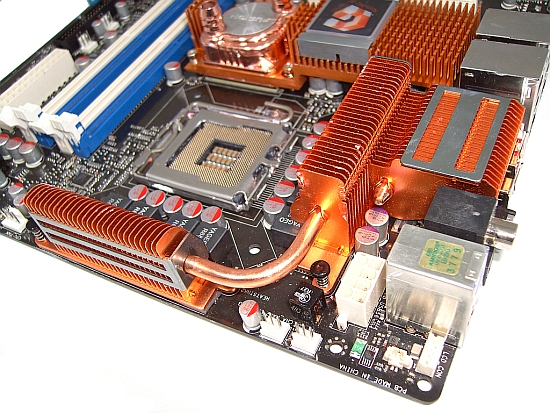 |
The EPS 12V connector is near the CPU socket area. An internal S/PDIF pin-out and the connector for the LCD poster is located at the top left hand corner of the board (lower right of the picture). CPU voltage comes via the 8-phase ADP 3228 PWM controller (4 MOSFETs per phase for a total of 32 MOSFETs). The PWM cooling heatsink is large enough to dissipate heat under high Vcore and heavy processor loading; however, the central MOSFETs do not have good heatsink contact as the board bows slightly under the pressure of a CPU cooler, pulling the central MOSFETs away from the sink. If you plan to push high levels of Vcore, it may be prudent to use additional non-conductive thermal paste over the central MOSFETs to ensure heat transfer. Again, ASUS has chosen to use a hybrid heatsink/water block combination for the Northbridge cooling solution. We approached this combo with a little trepidation after our experience with water-cooling the NB on the Maximus Formula last month.
This time, we used screw fitting hose clamps, rather than the supplied spring clamps to ensure that our 1/2" tubing would not work loose during testing. ASUS has assured us that ROG boards will be shipping with screw-type hose fittings in the future. We also removed the entire heatsink assembly to check for contact between the heatsink and Northbridge HIS (Integrated Heat Spreader). The thermal pads ASUS uses form a very secure bond to the Northbridge at ambient temperatures; as a result, we had to use a hair dryer to heat the board plus 40 degrees to work the block loose. We advise users not to force the heatsink assembly away from the board. We have seen examples of Northbridge chips pulled off boards by over-zealous users - a quick way to kill a board without a chance for an RMA if a problem arises in the future.
IHS to heatsink contact was a lot better on this board than our first Maximus Formula sample (something later fixed in shipping boards). We still decided it best to remove the stock cooling pad with an acetone based cleaner and use a good thermal paste instead, as the paste has a lower thermal resistance than thermal pads allowing for better thermal transfer. A combination of air- and water-cooling for the Northbridge brings the best results. The X38 chipset does seem to be heat sensitive; temperatures in excess of 45-50C can cause system instability.
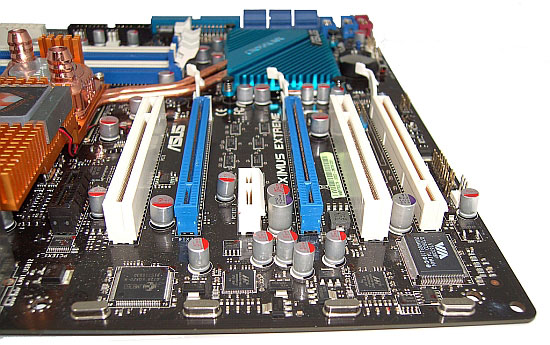 |
Any board that uses the x38 chipset is bound to have 2 X PCI-E 2.0 slots. ASUS has gone a step further and used a bridge chip to allow a third PCI-E 1.1 slot running at x8 speed. The exciting upshot for users is the potential to run Tri-Fire (future drivers permitting), albeit with the PCI-E slots running in 16x-16x-8x mode. The obvious side effect is this configuration leaves little room between the PCI-E slots. Users who wish to use full-coverage water blocks to cool their graphics cards will need to either modify their PC cases or use GPU-only water blocks.
The top PCI-E x1 slot is for the supplied SupremeFX II soundcard, featuring the ADI 1988B 8-channel High Definition Audio CODEC. Two PCI slots are available, though in the case of using dual graphics cards the top PCI slot is the only port that may be used. Finally, an onboard USB connector is located above the lowest PCI-E port.
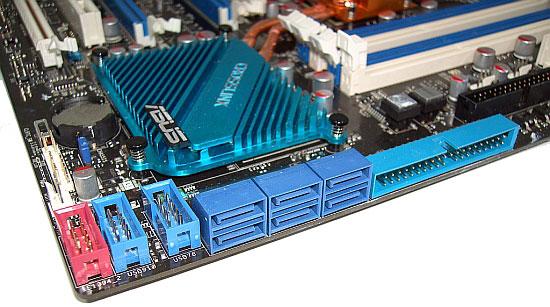 |
The Intel ICH9R Southbridge provides us with six SATA ports. Below the ports, we find two USB connectors and an IEEE 1394a port. The IDE connector sits above the SATA connectors, remaining accessible even when using long graphic cards in the top PEG slot.
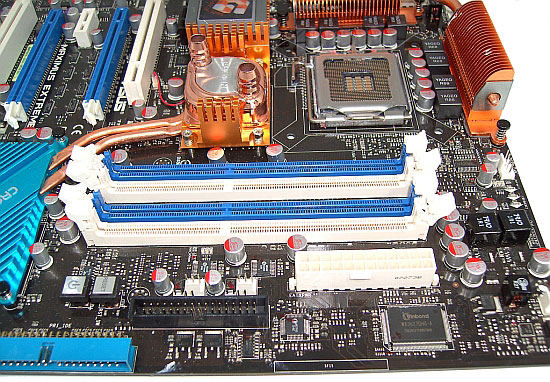 |
We have four (almost) centrally placed DIMM slots for memory, offering full support for 8GB. ASUS uses this memory slot layout to minimize the potential of inductance and signal crosstalk, a wise decision based upon the potential speed that DDR3 brings to the table. The floppy drive connector sits just in front of the DIMM slots. To the right of this we have the 24-pin ATX 12V connector. As mentioned earlier, the added width of this motherboard ensures plenty of room around all peripheral connectors on the right side of the board. The power and reset switches are just behind the IDE connector, keeping them exposed for use even when multiple graphics cards are present.
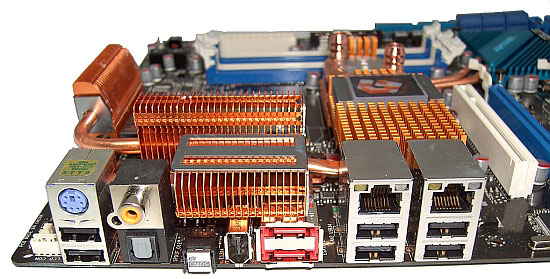 |
The rear IO panel features a PS/2 keyboard port with two USB slots directly underneath; users with a PS/2 mouse will need a PS/2 to USB adaptor. A Coaxial S/PDIF output is also present, together with a TOSLINK output. To the right we have the Clear CMOS button, making it easy to clear the CMOS even after installing the board in a case. There is a rear FireWire port, dual Gigabit LAN (featuring teaming support), and four additional USB ports. In addition, ASUS also provides two e-SATA ports on the rear IO plate.










27 Comments
View All Comments
markglh - Sunday, January 13, 2008 - link
Does the Thermalright Ultra-120 Extremem fit ok on this motherboard in a position so that it blows air out of the case? I was worried that the fusion waterblock and the heatsink at the top of the board might be too tall.thanks.
astronaute - Wednesday, December 26, 2007 - link
Can someone explain please why in BIOS screenshots we can see FSB 400 and QX6600 FSB is more then 1000 ?Sorry if my question is stupid :)
Rajinder Gill - Sunday, December 30, 2007 - link
The BIOS screenshots shown are provided only to illustrate which BIOS functions are available for the user. They have no direct correlation whatsoever with a Q6600 or it's FSB.regards
Raja
qquizz - Thursday, December 13, 2007 - link
With a name like Maximus Extreme the board better be one bad mofo, err... i mean mobo.Zak - Monday, December 10, 2007 - link
Something's not right, C2D Extreme and 8800Ultra??? I get over 12000 in 3D Mark 2006 with a $99 Gigabyte mobo, 3GHz C2D @3.8Ghz with Tuniq Tower, 800MHz DDR2 and 8800GTX slightly overclocked.Z.
Azured - Monday, December 10, 2007 - link
No that seems allright. The test is run with a Q6600 (actually a QX6850 with a lower multiplier to simulate the Q6600) at stock 2.4GHz. considerably slower than your C2D at 3.8GHz.Zak - Monday, December 10, 2007 - link
Oh, I must have misread something then, thanks:)Z.
takumsawsherman - Monday, December 10, 2007 - link
Now this blows me away. $350 and still no Firewire800! How much money should you have to pay before you get a feature that was commercially introduced 4 years ago. Instead, you get the slower variant that first saw real action 8 years ago. What's next, USB 1.1?Maybe I didn't read the Newegg price tag correctly, but if I did, this is a travesty. And of course, no room for a PS/2 mouse port. I mean, a single PS/2 port, in a non-standard position. At first, it may seem to be no big deal, but why make it different that almost every other config? So when muscle-memory leads you blindy around the back of the case when you install a keyboard, you have to hunt around more. Not to mention that most PS/2 devices are pretty static in that people aren't switching them all the time. USB, on the other hand, is more frequently connected and disconnected. Having the PS/2 keyboard plugged in gives you limited room to change USB stuff, especially if you have another USB device plugged in. If the PS/2 port was on the bottom, you can stack a USB connector on top and still have finger room to add or remove another, without risking disconnection of another cable (PS/2 for example).
A ridiculous board, at a ridiculous price.
retrospooty - Monday, December 10, 2007 - link
not to burst your bubble but, Firewire 800 is never going to take off. Before it got started it was surpassed and totally obsoleted by eSATA. You wont ever see it as a standard feature on even high end motherboards. If you have use for it, you need to by an adaptor card for it.Etern205 - Monday, December 10, 2007 - link
Yes, eSATA is faster than Firewire 800 which is why eSATA is gaining popularity than Fire800. As for only 1 PS/2 port, if those articles or rumors are correct, then by the time ICH10 comes out we'll not see anymore PS/2 ports or PCI slots.In a question unrelated to this article, for those of you that have a usb wireless mouse or keyboard are you able to switch between the OSes if you guy have a dual or mult-boot system?
Thanks!